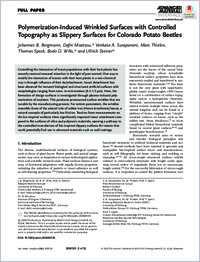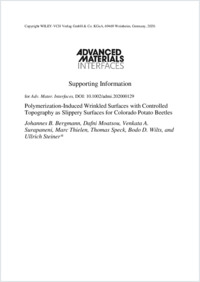Polymerization‐induced wrinkled surfaces with controlled topography as slippery surfaces for colorado potato beetles
- Bergmann, Johannes B. Adolphe Merkle Institute, University of Fribourg Chemin des Verdiers 4 Fribourg 1700 Switzerland
- Moatsou, Dafni Institute of Organic Chemistry, Karlsruhe Institute of Technology Fritz‐Haber‐Weg 6 Karlsruhe 76131 Germany
- Surapaneni, Venkata A. Plant Biomechanics Group, Botanic Garden, Faculty of Biology, University of Freiburg Schänzlestrasse 1 Freiburg 79104 Germany - Freiburg Materials Research Center (FMF)University of Freiburg Stefan‐Meier‐Strasse 21 Freiburg 79104 Germany
- Thielen, Marc Plant Biomechanics Group, Botanic Garden, Faculty of Biology, University of Freiburg Schänzlestrasse 1 Freiburg 79104 Germany - Freiburg Materials Research Center (FMF)University of Freiburg Stefan‐Meier‐Strasse 21 Freiburg 79104 Germany
- Speck, Thomas Plant Biomechanics Group, Botanic Garden, Faculty of Biology, University of Freiburg Schänzlestrasse 1 Freiburg 79104 Germany - Freiburg Materials Research Center (FMF)University of Freiburg Stefan‐Meier‐Strasse 21 Freiburg 79104 Germany - Cluster of Excellence liv, Mat, S@ FIT‐ Freiburg Center for Interactive Materials and Bioinspired Technologies, University of Freiburg Georges‐Köhler‐Allee 105 Freiburg 79110 Germany
- Wilts, Bodo D. Adolphe Merkle Institute, University of Fribourg Chemin des Verdiers 4 Fribourg 1700 Switzerland
- Steiner, Ullrich Adolphe Merkle Institute, University of Fribourg Chemin des Verdiers 4 Fribourg 1700 Switzerland
-
27.04.2020
Published in:
- Advanced Materials Interfaces. - 2020, p. 2000129
English
Controlling the interaction of insect populations with their host plants has recently received renewed attention in the light of pest control. One way to modify the interaction of insects with their host plants in a non‐chemical way is through influence of their de/attachment. Insect detachment has been observed for textured biological and structured artificial surfaces with morphologies ranging from nano‐ to micrometers (0.3–1.5 µm). Here, the formation of design surfaces is investigated through plasma‐induced polymerization of acrylates. This produces pronounced surface wrinkles that are tunable by the manufacturing process. For certain parameters, the wrinkles resemble those of the adaxial side of rubber tree (Hevea brasiliensis) leaves, a natural example of particularly low friction. Traction force measurements on the bio‐inspired surfaces show significantly impacted insect attachment compared to flat surfaces of silica and polymeric materials, opening a pathway to the controlled manufacture of bio‐inspired slippery surfaces for insects that could potentially find use in advanced materials such as wall coatings.
- Faculty
- Faculté des sciences et de médecine
- Department
- AMI - Physique de la matière molle
- Language
-
- English
- Classification
- Chemistry
- License
-
License undefined
- Identifiers
-
- RERO DOC 328421
- DOI 10.1002/admi.202000129
- Persistent URL
- https://folia.unifr.ch/unifr/documents/308645
Other files
Statistics
Document views: 151
File downloads:
- pdf: 173
- Supplementary material: 106

